Will NILM Technology Replace Multi-Meter Telemetry Systems for Monitoring Electricity Consumption?
Abstract
:1. Introduction
- How can we identify and separate the measurement components of individual devices included in the collective signal?
- Why has NILM technology not replaced multi-meter metering systems so far?
2. State of the Art Analysis
2.1. NILM System Structure
- low frequency measurements (0–60 Hz),
- medium frequencies measurements (1–50 kHz),
- high frequency measurements (0.5–50 MHz).
- Two-state devices: devices whose operating status can be one of two values (on/off) with one time-independent operating parameter (usually it is power).
- Discrete devices which operating status can be inactive or active in one of countable values of time independent parameter (n − 1 value of power).
- Devices with an infinite number of states: Devices whose power consumption changes smoothly and can be different between their subsequent activations. This is the class of devices that is most difficult to identify due to their variable nature. Determining a profile that would allow to develop a signature that is constant during the use of such a device is very demanding [13].
- Constant energy consumers: devices that have only one permanent mode of operation.
2.2. Signatures and Characteristic Values
2.3. Macroscopic Signatures
2.4. Microscopis Signatures
2.5. Unconventional Signatures
2.6. Disaggregation Algorithms
2.7. Supervised Learning Algorithms
2.8. Event-Based Algorithms
2.9. Optimization Methods
2.10. Unsupervised Learning Algorithms
2.11. Evaluation of the Accuracy of the Disaggregation Algorithms
- TPR (true positive rate) and FPR (false positive rate), defined as:where: TP (true positive) is the number of true positive events, FN (false negative) is the number of false negative events, FP (false positive) is the number of false positive events, and TN (true negative) is the number of true negative events. TPR and FPR can be visualized by the receiver operating characteristic (ROC) presented in Figure 3, which is often used in comparing pattern recognition algorithms [8]. On the ROC curve, the best detector should be at the position corresponding to TPR = 1 and FPR = 0.
- Precision and Recall: similar to TPR and FPR, precision and recall (sensitivity/sensitiveness) use the values of TP, TN, FP, and FN, and are defined as:
- F-measure (F1 or F-score): the F-measure is the harmonic mean using the definitions of precision and sensitivity and is defined as:where a positive factor β determines the influence of the precision and sensitivity values on the F-measure result (β = 1—precision and sensitivity equally important; β < 1—precision more important; β > 1—sensitivity more important).
- Confusion matrix: each element of the confusion matrix represents how often it was confused with other elements of the matrix or how often it was classified correctly.
- Total energy of change: The previous metrics assume that all classification events are equally important, although some devices consume more energy than others. Therefore, considering the weights for each device could help to introduce a parameter to normalize this phenomenon [32].
- Hamming loss: all information lost due to misclassification can be defined by the Hamming loss, which is the ratio of misclassified labels to all labels [58].
2.12. Open Data Sources
- REDD: Reference Energy Disaggregation dataset, containing data from six households, published in 2011, was the first open dataset that could be used to study disaggregation algorithms and at the same time became one of the most widely used for this purpose [59].
- BLUED: The Building Level fully labeled dataset for Electricity Disaggregation was published in [60]. The BLUED dataset contains measured voltage and current data at 12 kHz, collected in one household over a period of one week. Although the dataset does not have data on the electricity use of individual devices, it does contain labels describing exactly when and what devices were activated, which is sufficient for evaluating event-based algorithms.
- Smart*: The Smart* project report published in 2012 [61] includes data from three homes in Massachusetts, USA. Although it does not have data on the use of energy by individual devices in two houses, it does contain data on the temperature and humidity inside the houses and the weather.
- Household Electricity Survey: The Household Electricity Survey is a dataset published in 2012 with data from 251 homes, with 14 of them measured aggregate grid load [62].
- Tracebase: The Tracebase dataset has data from both home and office devices that have been collected using Plugwise devices [63].
- AMPds: The Almanac of Minutely Power dataset was published in [64] and includes data collected in one home over a period of one year. In 2014, the AMPds2 dataset was published, which included data from the following year. The dataset includes measurements of the aggregated load and energy used by individual devices.
- iAWE: Indian data for Ambient Water and Electricity Sensing collected in one home over 73 days was published in [65]. The dataset includes measurements of the aggregated load and energy used by individual devices.
- BERDS: BERkeley EneRgy Disaggregation Dataset contains a set of measurements taken on the UC Berkeley campus, published in [66]. The tested devices include lighting units, pumps, heating, ventilation, and air conditioning. For some of the devices, additional data has been provided in the form of, e.g., air flows.
- ACS-F1: The Appliance Consumption Signatures-Fribourg 1 dataset contains measured electricity consumption data (active power, reactive power, current RMS, phase between voltage and current) collected twice an hour from one hundred household appliances [67].
- UK-DALE: The UK Domestic Appliance-Level Electricity dataset published in [68] includes data from five homes collected over 655 days at 16 kHz for aggregate power and ⅙ Hz for individual appliance power consumption.
- ECO: The Electricity Consumption and Occupancy dataset published in [69] includes data collected from six homes in Switzerland. Data was collected at a sampling frequency of 1 Hz.
- GREEND: The GREEND dataset published in [70] includes data collected from nine homes in Italy. The sampling frequency was 1 Hz.
- SustData: The SustData dataset contains data collected from 50 homes at one-minute intervals [71].
- COMBED: The Commercial Building Energy Dataset contains data from 200 sensors collected on a campus in India at intervals of 30 s [72].
- PLAID: The Plug-Level Appliance Identification Dataset contains 30 kHz rate sampled current and voltage of eleven different household appliances present in fifty-five homes in the United States [73].
- DRED: The Dutch Residential Energy Dataset was published in 2015 and provides information on the energy performance of homes in the Netherlands [74].
- Dataport (Pecan Street): The Dataport Dataset published by Pecan Street Inc. is the largest source of disaggregated energy measurement data in the world, freely available for academic purposes [75]. The database contains data from 722 homes located in Texas, Colorado, and California. The data were collected at one-minute intervals and include the aggregated load and for each device separately.
- OOLL: The Controlled On/Off Loads Library dataset published by the PRISME laboratory of the Université d’Orléans in France contains measurements of current and voltage with a frequency of 100 kHz for forty-two devices belonging to one of twelve classes [76].
- WHITED: The Worldwide Household and Industry Transient Energy Dataset contains start-up data (first five seconds) of one hundred and ten different devices in six different regions around the world, collected at a sampling rate of 44 kHz [77].
2.13. Open-Source Tools for NILM
3. Methodology
4. Experiment Design
- To implement the experiment scenarios, the devices will be controlled in the given research scenarios by an external controller, implemented using the RaspberryPI microcomputer.
- The non-invasive YHDC AC SCT 013-030 sensor will be used to measure the current,
- Data will be collected by the LabJack U3 chip and stored on the Apache Kafka server. The data will be processed using analytical algorithms selected for the experiment on this server.
- Sampling frequency f = 2 kHz (experimentally determined for the built system).
5. Results Analysis
- k-Nearest Neighbors,
- Neural Networks,
- Random Forest.
5.1. k-Nearest Neighbors (k-NN)
5.2. Neural Networks
5.3. Random Forest
5.4. Comparison of Methods
5.5. Prediction of Power Consumed by Devices
6. BLUED Data Analysis
7. Conclusions, Implications, Limitations, and Future Work
7.1. Research Conclusions
7.2. Implications for Theory and Practice
7.3. Limitations and Potential Future Research Directions
Author Contributions
Funding
Data Availability Statement
Acknowledgments
Conflicts of Interest
Abbreviations
| AFHMM | Additive Factorial Hidden Markov Models |
| ALM | Appliance Load Monitoring |
| AMI | Advanced Metering Infrastructure |
| ANN | Artificial Neural Networks |
| BIF | Bayesian Inference Framework |
| DNNs | Deep Neural Networks |
| EPRI | Electric Power Research Institute) |
| FDII | Fault Detection, Identification, and Isolation |
| FHMM | Factorial Hidden Markov Model |
| FPR | False Positive Rate |
| GMM | Gaussian Mixture Model |
| HMM | Hidden Markov Models |
| HTA | Histogram Thinning Approach |
| HVAC | Heating, Light, Ventilation, Air-Conditioning |
| ILM | Intrusive Load Monitoring |
| k-NN | k-Nearest Neighbors |
| MIT | Massachusetts Institute of Technology |
| MLA | Machine Learning Algorithms |
| MLE | Maximum Likelihood Estimator |
| MPI | Main Power Input |
| NIALM | Non-intrusive Appliance Load Monitoring) |
| NILM | Non-intrusive Load Monitoring |
| NILMTK | Non-intrusive Load Monitoring Toolkit |
| PDM | Predictive maintenance |
| ReLU | Rectifier Linear Unit |
| STFT | Short-time Fourier Transform |
| SVM | Supporting Vector Machines |
| TPR | True Positive Rate |
References
- Gawin, B.; Marcinkowski, B. Setting up Energy Efficiency Management in Companies: Preliminary Lessons Learned from the Petroleum Industry. Energies 2020, 13, 5604. [Google Scholar] [CrossRef]
- Mahi-al-rashid, A.; Hossain, F.; Anwar, A.; Azam, S. False Data Injection Attack Detection in Smart Grid Using Energy Consumption Forecasting. Energies 2022, 15, 4877. [Google Scholar] [CrossRef]
- Puente, C.; Palacios, R.; González-Arechavala, Y.; Sánchez-Úbeda, E.F. Non-Intrusive Load Monitoring (NILM) for Energy Disaggregation Using Soft Computing Techniques. Energies 2020, 13, 3117. [Google Scholar] [CrossRef]
- Rafati, A.; Shaker, H.R.; Ghahghahzadeh, S. Fault Detection and Efficiency Assessment for HVAC Systems Using Non-Intrusive Load Monitoring: A Review. Energies 2022, 15, 341. [Google Scholar] [CrossRef]
- Shin, C.; Rho, S.; Lee, H.; Rhee, W. Data Requirements for Applying Machine Learning to Energy Disaggregation. Energies 2019, 12, 1696. [Google Scholar] [CrossRef] [Green Version]
- Mari, S.; Bucci, G.; Ciancetta, F.; Fiorucci, E.; Fioravanti, A. A Review of Non-Intrusive Load Monitoring Applications in Industrial and Residential Contexts. Energies 2022, 15, 9011. [Google Scholar] [CrossRef]
- Fotopoulou, M.; Petridis, S.; Karachalios, I.; Rakopoulos, D. A Review on Distribution System State Estimation Algorithms. Appl. Sci. 2022, 12, 11073. [Google Scholar] [CrossRef]
- Zoha, A.; Gluhak, A.; Imran, M.; Rajasegarar, S. Non-Intrusive Load Monitoring Approaches for Disaggregated Energy Sensing: A Survey. Sensors 2012, 12, 16838–16866. [Google Scholar] [CrossRef] [Green Version]
- Hart, G.W. Nonintrusive appliance load monitoring. Proc. IEEE 1992, 80, 1870–1891. [Google Scholar] [CrossRef]
- Yu, J.; Gao, Y.; Wu, Y.; Jiao, D.; Su, C.; Wu, X. Non-Intrusive Load Disaggregation by Linear Classifier Group Considering Multi-Feature Integration. Appl. Sci. 2019, 9, 3558. [Google Scholar] [CrossRef] [Green Version]
- Laouali, I.; Gomes, I.; da Ruano, M.G.; Bennani, S.D.; El Fadili, H.; Ruano, A. Energy Disaggregation Using Multi-Objective Genetic Algorithm Designed Neural Networks. Energies 2022, 15, 9073. [Google Scholar] [CrossRef]
- Biansoongnern, S.; Plungklang, B. Non-Intrusive Appliances Load Monitoring (NILM) for Energy Conservation in Household with Low Sampling Rate. Procedia Comput. Sci. 2016, 86, 172–175. [Google Scholar] [CrossRef] [Green Version]
- Chrysostomou, G.; Shikhin, V.; Shikhina, A. Electrical Energy Supply Control Support via Meters Data Ellipsoidal Approximation in Smart Grids. Procedia Comput. Sci. 2017, 103, 287–294. [Google Scholar] [CrossRef]
- Norford, L.K.; Leeb, S.B. Non-intrusive electrical load monitoring in commercial buildings based on steady-state and transient load-detection algorithms. Energy Build. 1996, 24, 51–64. [Google Scholar] [CrossRef]
- Laughman, C.; Lee, K.; Cox, R.; Shaw, S.; Leeb, S.; Norford, L.; Armstrong, P. Power signature analysis. IEEE Power Energy Mag. 2003, 1, 56–63. [Google Scholar] [CrossRef]
- Chang, H.-H.; Yang, H.-T.; Lin, C.-L. Load Identification in Neural Networks for a Non-intrusive Monitoring of Industrial Electrical Loads. In Computer Supported Cooperative Work in Design IV; Shen, W., Yong, J., Yang, Y., Barthès, J.-P.A., Luo, J., Eds.; Springer: Berlin/Heidelberg, Germany, 2008; pp. 664–674. [Google Scholar]
- Gupta, S.; Reynolds, M.S.; Patel, S.N. ElectriSense. In Proceedings of the 12th ACM International Conference on Ubiquitous Computing, Pittsburgh, PA, USA, 26–29 September 2010; ACM: New York, NY, USA, 2010; pp. 139–148. [Google Scholar]
- Berenguer, M.; Giordani, M.; Giraud-By, F.; Noury, N. Automatic detection of activities of daily living from detecting and classifying electrical events on the residential power line. In Proceedings of the HealthCom 2008-10th International Conference on e-health Networking, Applications and Services, Singapore, 7–9 July 2008; pp. 29–32. [Google Scholar]
- Najafi, B.; Moaveninejad, S.; Rinaldi, F. Data Analytics for Energy Disaggregation: Methods and Applications. In Big Data Application in Power Systems; Elsevier: Amsterdam, The Netherlands, 2018; pp. 377–408. [Google Scholar]
- Patel, S.N.; Robertson, T.; Kientz, J.A.; Reynolds, M.S.; Abowd, G.D. At the Flick of a Switch: Detecting and Classifying Unique Electrical Events on the Residential Power Line (Nominated for the Best Paper Award). In UbiComp 2007: Ubiquitous Computing; Krumm, J., Abowd, G.D., Seneviratne, A., Strang, T., Eds.; Springer: Berlin/Heidelberg, Germany, 2007; pp. 271–288. [Google Scholar]
- Drenker, S.; Kader, A. Nonintrusive monitoring of electric loads. IEEE Comput. Appl. Power 1999, 12, 47–51. [Google Scholar] [CrossRef]
- Cole, A.I.; Albicki, A. Algorithm for nonintrusive identification of residential appliances. In Proceedings of the1998 IEEE International Symposium on Circuits and Systems (ISCAS), Monterey, CA, USA, 31 May–3 June 1998; Volume 3, pp. 338–341. [Google Scholar]
- Cole, A.I.; Albicki, A. Data extraction for effective non-intrusive identification of residential power loads. In Proceedings of the IMTC/98 Conference Proceedings. IEEE Instrumentation and Measurement Technology Conference. Where Instrumentation Is Going (Cat. No. 98CH36222), St. Paul, MN, USA, 18–21 May 1998; Volume 2, pp. 812–815. [Google Scholar]
- Liang, J.; Ng, S.K.K.; Kendall, G.; Cheng, J.W.M. Load Signature Study—2014; Part I: Basic Concept, Structure, and Methodology. IEEE Trans. Power Deliv. 2010, 25, 551–560. [Google Scholar] [CrossRef]
- Leeb, S.B.; Shaw, S.R.; Kirtley, J.L. Transient event detection in spectral envelope estimates for nonintrusive load monitoring. IEEE Trans. Power Deliv. 1995, 10, 1200–1210. [Google Scholar] [CrossRef] [Green Version]
- Lee, W.Y.; Lee, Y.C.; Sokolov, K.; Lee, H.J.; Moon, I. LED projection displays. In Nonimaging Optics and Efficient Illumination Systems; Winston, R., Koshel, R.J., Eds.; SPIE: Denver, CO, USA, 2004; Volume 5529, pp. 1–7. [Google Scholar]
- Lam, H.; Fung, G.; Lee, W. A Novel Method to Construct Taxonomy Electrical Appliances Based on Load Signaturesof. IEEE Trans. Consum. Electron. 2007, 53, 653–660. [Google Scholar] [CrossRef] [Green Version]
- Zeifman, M.; Roth, K. Nonintrusive appliance load monitoring: Review and outlook. IEEE Trans. Consum. Electron. 2011, 57, 76–84. [Google Scholar] [CrossRef]
- Dong, M.; Meira, P.C.; Xu, W.; Chung, C.Y. Non-Intrusive Signature Extraction for Major Residential Loads. IEEE Trans. Smart Grid 2013, 4, 1421–1430. [Google Scholar] [CrossRef] [Green Version]
- Abubakar, I.; Khalid, S.N.; Mustafa, M.W.; Shareef, H.; Mustapha, M. Application of load monitoring in appliances’ energy management—A review. Renew. Sustain. Energy Rev. 2017, 67, 235–245. [Google Scholar] [CrossRef]
- Kolter, J.; Batra, S.; Ng, A. Energy Disaggregation via Discriminative Sparse Coding. Adv. Neural Inf. Process. Syst. 2010, 23, 1153–1161. [Google Scholar]
- Anderson, K.D. Non-Intrusive Load Monitoring: Disaggregation of Energy by Unsupervised Power Consumption Clustering. Ph.D. Thesis, Carnegie Mellon University, Pittsburgh, PA, USA, 2014. [Google Scholar]
- Hart, G.W.; Kern, E.C.J.; Schweppe, F.C. Non-intrusive Appliance Monitor Apparatus. U.S. Patent 4858141, 15 August 1989. [Google Scholar]
- Du, Z.; Li, J.; Zhu, L.; Lu, K.; Shen, H.T. Adversarial Energy Disaggregation. ACM/IMS Trans. Data Sci. 2021, 2, 1–16. [Google Scholar] [CrossRef]
- Kelly, J.; Knottenbelt, W. Neural NILM: Deep Neural Networks Applied to Energy Disaggregation. arXiv 2015, arXiv:1507.06594. [Google Scholar]
- Zhang, C.; Zhong, M.; Wang, Z.; Goddard, N.; Sutton, C. Sequence-to-Point Learning With Neural Networks for Non-Intrusive Load Monitoring. In Proceedings of the Thirty-Second AAAI Conference on Artificial Intelligence (AAAI-18), New Orleans, LO, USA, 2–7 February 2018; Volume 32. [Google Scholar] [CrossRef]
- Pan, Y.; Liu, K.; Shen, Z.; Cai, X.; Jia, Z. Sequence-To-Subsequence Learning With Conditional Gan For Power Disaggregation. In Proceedings of the ICASSP 2020—2020 IEEE International Conference on Acoustics, Speech and Signal Processing (ICASSP), Barcelona, Spain, 4–8 May 2020; pp. 3202–3206. [Google Scholar]
- Leeb, S.B.; Kirtley, J.L. A Conjoint Pattern Recognition Approach to Nonintrusive Load Monitoring; Massachusetts Institute of Technology: Cambridge, MA, USA, 1993. [Google Scholar]
- Farinaccio, L.; Zmeureanu, R. Using a pattern recognition approach to disaggregate the total electricity consumption in a house into the major end-uses. Energy Build 1999, 30, 245–259. [Google Scholar] [CrossRef]
- Marchiori, A.; Hakkarinen, D.; Han, Q.; Earle, L. Circuit-Level Load Monitoring for Household Energy Management. IEEE Pervasive Comput. 2011, 10, 40–48. [Google Scholar] [CrossRef]
- Srinivasan, D.; Ng, W.S.; Liew, A.C. Neural-Network-Based Signature Recognition for Harmonic Source Identification. IEEE Trans. Power Deliv. 2006, 21, 398–405. [Google Scholar] [CrossRef]
- Ruzzelli, A.G.; Nicolas, C.; Schoofs, A.; O’Hare, G.M.P. Real-Time Recognition and Profiling of Appliances through a Single Electricity Sensor. In Proceedings of the 7th Annual IEEE Communications Society Conference on Sensor, Mesh and Ad Hoc Communications and Networks, Boston, MA, USA, 21–25 June 2010; pp. 1–9. [Google Scholar]
- Zia, T.; Bruckner, D.; Zaidi, A. A hidden Markov model based procedure for identifying household electric loads. In Proceedings of the 37th Annual Conference of the IEEE Industrial Electronics Society (IECON 2011), Melbourne, VIC, Australia, 7–10 November 2011; pp. 3218–3223. [Google Scholar]
- Figueiredo, M.B.; de Almeida, A.; Ribeiro, B. An Experimental Study on Electrical Signature Identification of Non-Intrusive Load Monitoring (NILM) Systems. In Adaptive and Natural Computing Algorithms; Dobnikar, A., Lotrič, U., Šter, B., Eds.; Springer: Berlin/Heidelberg, Germany, 2011; pp. 31–40. [Google Scholar]
- Kolter, J.; Batra, S.; Andrew, N. Energy Disaggregation via Discriminative Sparse Coding. In Advances in Neural Information Processing Systems; Lafferty, J., Williams, C., Shawe-Taylor, J., Zemel, R., Culotta, A., Eds.; Curran Associates, Inc.: Vancouver, BC, Canada, 2010; Volume 23. [Google Scholar]
- Lai, Y.X.; Lai, C.F.; Huang, Y.M.; Chao, H.C. Multi-appliance recognition system with hybrid SVM/GMM classifier in ubiquitous smart home. Inf. Sci. 2013, 230, 39–55. [Google Scholar] [CrossRef]
- Breiman, L. Random Forests. Mach. Learn 2001, 45, 5–32. [Google Scholar] [CrossRef] [Green Version]
- Raileanu, L.E.; Stoffel, K. Theoretical Comparison between the Gini Index and Information Gain Criteria. Ann. Math. Artif. Intell 2004, 41, 77–93. [Google Scholar] [CrossRef]
- Suzuki, K.; Inagaki, S.; Suzuki, T.; Nakamura, H.; Ito, K. Nonintrusive appliance load monitoring based on integer programming. In Proceedings of the 2008 SICE Annual Conference, Tokyo, Japan, 20–22 August 2008; pp. 2742–2747. [Google Scholar]
- Baranski, M.; Voss, J. Nonintrusive appliance load monitoring based on an optical sensor. In Proceedings of the 2003 IEEE Bologna Power Tech Conference Proceedings, Bologna, Italy, 23–26 June 2003; Volume 4, p. 8. [Google Scholar]
- Schoofs, A.; Guerrieri, A.; Delaney, D.T.; O’Hare, G.M.P.; Ruzzelli, A.G. ANNOT: Automated Electricity Data Annotation Using Wireless Sensor Networks. In Proceedings of the 2010 7th Annual IEEE Communications Society Conference on Sensor, Mesh and Ad Hoc Communications and Networks (SECON), Boston, MA, USA, 21–25 June 2010; pp. 1–9. [Google Scholar]
- Kim, H.; Marwah, M.; Arlitt, M.; Lyon, G.; Han, J. Unsupervised Disaggregation of Low Frequency Power Measurements. In Proceedings of the 2011 SIAM International Conference on Data Mining, Mesa, AZ, USA, 28–30 April 2011; Society for Industrial and Applied Mathematics: Philadelphia, PA, USA, 2011; pp. 747–758. [Google Scholar]
- Gonçalves, H.; Ocneanu, A.; Berges, M.E. Unsupervised Disaggregation of Appliances Using Aggregated Consumption Data. 2011. Available online: https://www.semanticscholar.org/paper/Unsupervised-disaggregation-of-appliances-using-Gon%C3%A7alves-Ocneanu/5531e05c2c76b150473c218a749bd83372d691e5 (accessed on 28 January 2023).
- Parson, O.; Ghosh, S.; Weal, M.; Rogers, A. An unsupervised training method for non-intrusive appliance load monitoring. Artif. Intell. 2014, 217, 1–19. [Google Scholar] [CrossRef]
- Johnson, M.J.; Willsky, A.S. Bayesian Nonparametric Hidden Semi-Markov Models. arXiv 2012, arXiv:1203.1365. [Google Scholar]
- Kolter, J.Z.; Jaakkola, T. Approximate Inference in Additive Factorial HMMs with Application to Energy Disaggregation. In Proceedings of the Fifteenth International Conference on Artificial Intelligence and Statistics; 2012; Volume 22, pp. 1472–1482. Available online: https://proceedings.mlr.press/v22/zico12.html (accessed on 28 January 2023).
- Makonin, S. Approaches to Non-Intrusive Load Monitoring (Nilm) in the Home; BTech, British Columbia Institute of Technology: Burnaby, BC, Canada, 2012. [Google Scholar]
- Batra, N.; Kelly, J.; Parson, O.; Dutta, H.; Knottenbelt, W.; Rogers, A.; Singh, A.; Srivastava, M. NILMTK: An Open Source Toolkit for Non-Intrusive Load Monitoring. In Proceedings of the 5th International Conference on Future Energy Systems, Cambridge, UK, 11–13 June 2014; Association for Computing Machinery: New York, NY, USA, 2014; pp. 265–276. [Google Scholar]
- Kolter, J.Z.; Johnson, M.J. REDD: A public data set for energy disaggregation research. In Proceedings of the Workshop on Data Mining Applications in Sustainability (SIGKDD), San Diego, CA, USA, 24 August 2011; Volume 25, pp. 59–62. [Google Scholar]
- Anderson, K.; Ocneanu, A.; Benitez, D.; Carlson, D.; Rowe, A.; Berges, M. BLUED: A fully labeled public dataset for event-based non-intrusive load monitoring research. In Proceedings of the 2nd KDD Workshop on Data Mining Applications in Sustainability (SustKDD); 2012; Volume 7, pp. 1–5. Available online: https://www.inferlab.org/wp-content/uploads/2012/08/2012_anderson_SustKDD.pdf (accessed on 28 January 2023).
- Barker, S.; Mishra, A.; Irwin, D.; Cecchet, E.; Shenoy, P.; Albrecht, J. Smart*: An Open Data Set and Tools for Enabling Research in Sustainable Homes. Proc. SustKDD. 2012. Available online: https://lass.cs.umass.edu/papers/pdf/sustkdd12-smart.pdf (accessed on 28 January 2023).
- Zimmermann, J.-P.; Evans, M.; Griggs, J.; King, N.; Harding, L.; Roberts, P.; Evans, C. Household Electricity Survey: A study of Domestic Electrical Product Usage; Intertek Testing & Certification Ltd., 2012; pp. 213–214. Available online: https://assets.publishing.service.gov.uk/government/uploads/system/uploads/attachment_data/file/208097/10043_R66141HouseholdElectricitySurveyFinalReportissue4.pdf (accessed on 28 January 2023).
- Reinhardt, A.; Baumann, P.; Burgstahler, D.; Hollick, M.; Chonov, H.; Werner, M.; Steinmetz, R. On the accuracy of appliance identification based on distributed load metering data. In Proceedings of the 2012 Sustainable Internet and ICT for Sustainability (SustainIT), Pisa, Italy, 4–5 October 2012; pp. 1–9. [Google Scholar]
- Makonin, S.; Sung, W.; dela Cruz, R.; Yarrow, B.; Gill, B.; Popowich, F.; Bajic, I.V. Inspiring energy conservation through open source metering hardware and embedded real-time load disaggregation. In Proceedings of the 2013 IEEE PES Asia-Pacific Power and Energy Engineering Conference (APPEEC), Hong Kong, China, 8–11 December 2013; pp. 1–6. [Google Scholar]
- Batra, N.; Gulati, M.; Singh, A.; Srivastava, M.B. It’s Different: Insights into home energy consumption in India. In Proceedings of the 5th ACM Workshop on Embedded Systems for Energy-Efficient Buildings, Rome, Italy, 13–14 November 2013; ACM: New York, NY, USA, 2013; pp. 1–8. [Google Scholar]
- Maasoumy, M.; Sanandaji, B.; Poolla, K.; Vincentelli, A.S. Berds-berkeley energy disaggregation data set. In Proceedings of the Workshop on Big Learning at the Conference on Neural Information Processing Systems (NIPS), Lake Tahoe, NV, USA, 5–8 December 2013; Volume 7. [Google Scholar]
- Gisler, C.; Ridi, A.; Zufferey, D.; Khaled, O.A.; Hennebert, J. Appliance consumption signature database and recognition test protocols. In Proceedings of the 2013 8th International Workshop on Systems, Signal Processing and their Applications (WoSSPA), Algiers, Algeria, 12–15 May 2013; pp. 336–341. [Google Scholar]
- Kelly, J.; Knottenbelt, W. The UK-DALE dataset, domestic appliance-level electricity demand and whole-house demand from five UK homes. Sci. Data 2015, 2, 150007. [Google Scholar] [CrossRef] [PubMed] [Green Version]
- Beckel, C.; Kleiminger, W.; Cicchetti, R.; Staake, T.; Santini, S. The ECO data set and the performance of non-intrusive load monitoring algorithms. In Proceedings of the 1st ACM Conference on Embedded Systems for Energy-Efficient Buildings, Memphis, TN, USA, 5–6 November 2014; ACM: New York, NY, USA, 2014; pp. 80–89. [Google Scholar]
- Monacchi, A.; Egarter, D.; Elmenreich, W.; D’Alessandro, S.; Tonello, A.M. GREEND: An energy consumption dataset of households in Italy and Austria. In Proceedings of the 2014 IEEE International Conference on Smart Grid Communications (SmartGridComm), Venice, Italy, 3–6 November 2014; pp. 511–516. [Google Scholar]
- Pereira, L.; Quintal, F.; Gonçalves, R.; Nunes, N.J. SustData: A Public Dataset for ICT4S Electric Energy Research. 2014. Available online: https://osf.io/2ac8q/ (accessed on 28 January 2023).
- Batra, N.; Parson, O.; Berges, M.; Singh, A.; Rogers, A. A comparison of non-intrusive load monitoring methods for commercial and residential buildings. arXiv 2014, arXiv:1408.6595. [Google Scholar]
- Gao, J.; Giri, S.; Kara, E.C.; Bergés, M. PLAID: A public dataset of high-resoultion electrical appliance measurements for load identification research. In Proceedings of the 1st ACM Conference on Embedded Systems for Energy-Efficient Buildings, Memphis, TN, USA, 5–6 November 2014; ACM: New York, NY, USA, 2014; pp. 198–199. [Google Scholar]
- Uttama Nambi, A.S.N.; Reyes Lua, A.; Prasad, V.R. LocED: Location-Aware Energy Disaggregation Framework. In Proceedings of the 2nd ACM International Conference on Embedded Systems for Energy-Efficient Built Environments, Seoul, Republic of Korea, 4–5 November 2015; Association for Computing Machinery: New York, NY, USA, 2015; pp. 45–54. [Google Scholar]
- Parson, O.; Fisher, G.; Hersey, A.; Batra, N.; Kelly, J.; Singh, A.; Knottenbelt, W.; Rogers, A. Dataport and NILMTK: A building data set designed for non-intrusive load monitoring. In Proceedings of the 2015 IEEE Global Conference on Signal and Information Processing (GlobalSIP), Orlando, FL, USA, 14–16 December 2015; pp. 210–214. [Google Scholar]
- Picon, T.; Meziane, M.N.; Ravier, P.; Lamarque, G.; Novello, C.; Bunetel, J.-C.L.; Raingeaud, Y. COOLL: Controlled On/Off Loads Library, a Public Dataset of High-Sampled Electrical Signals for Appliance Identification. 2016. Available online: https://coolldataset.github.io/ (accessed on 28 January 2023).
- Kahl, M.; Haq, A.U.; Kriechbaumer, T.; Jacobsen, H.-A. Whited-a worldwide household and industry transient energy data set. In Proceedings of the 3rd International Workshop on Non-Intrusive Load Monitoring, Vancouver, BC, Canada, 14–15 May 2016; pp. 1–4. [Google Scholar]
- Renaux, D.P.B.; Pottker, F.; Ancelmo, H.C.; Lazzaretti, A.E.; Lima, C.R.E.; Linhares, R.R.; Oroski, E.; da Nolasco, L.S.; Lima, L.T.; Mulinari, B.M.; et al. A Dataset for Non-Intrusive Load Monitoring: Design and Implementation. Energies 2020, 13, 5371. [Google Scholar] [CrossRef]
- Kelly, J.; Knottenbelt, W. Metadata for Energy Disaggregation. In Proceedings of the 2014 IEEE 38th International Computer Software and Applications Conference Workshops, Washington, DC, USA, 21–25 July 2014; pp. 578–583. [Google Scholar]
- Kelly, J.; Batra, N.; Parson, O.; Dutta, H.; Knottenbelt, W.; Rogers, A.; Singh, A.; Srivastava, M. NILMTK v0.2: A non-intrusive load monitoring toolkit for large scale data sets. In Proceedings of the 1st ACM Conference on Embedded Systems for Energy-Efficient Buildings, Memphis, TN, USA, 5–6 November 2014; ACM: New York, NY, USA, 2014; pp. 182–183. [Google Scholar]
- Liaqat, R.; Sajjad, I.A. An Event Matching Energy Disaggregation Algorithm Using Smart Meter Data. Electronics 2022, 11, 3596. [Google Scholar] [CrossRef]
- Hasan, M.M.; Chowdhury, D.; Khan, M.Z.R. Non-Intrusive Load Monitoring Using Current Shapelets. Appl. Sci. 2019, 9, 5363. [Google Scholar] [CrossRef] [Green Version]
- Qi, B.; Liu, L.; Wu, X. Low-Rate Non-Intrusive Load Disaggregation with Graph Shift Quadratic Form Constraint. Appl. Sci. 2018, 8, 554. [Google Scholar] [CrossRef] [Green Version]
- Gawin, B.; Małkowski, R.; Główczewski, K.; Olszewski, M.; Tomasik, P. SESNED: Dataset for Event-Based Non-Intrusive Load Monitoring Research 2023. Available online: https://doi.org/10.34808/hth6-b756 (accessed on 28 January 2023).
- Laouali, I.; Ruano, A.; da Ruano, M.G.; Bennani, S.D.; el Fadili, H. Non-Intrusive Load Monitoring of Household Devices Using a Hybrid Deep Learning Model through Convex Hull-Based Data Selection. Energies 2022, 15, 1215. [Google Scholar] [CrossRef]
- Song, J.; Wang, H.; Du, M.; Peng, L.; Zhang, S.; Xu, G. Non-Intrusive Load Identification Method Based on Improved Long Short Term Memory Network. Energies 2021, 14, 684. [Google Scholar] [CrossRef]
- Xie, L.; Choi, D.-H.; Kar, S.; Poor, H.V. Fully Distributed State Estimation for Wide-Area Monitoring Systems. IEEE Trans. Smart Grid 2012, 3, 1154–1169. [Google Scholar] [CrossRef]
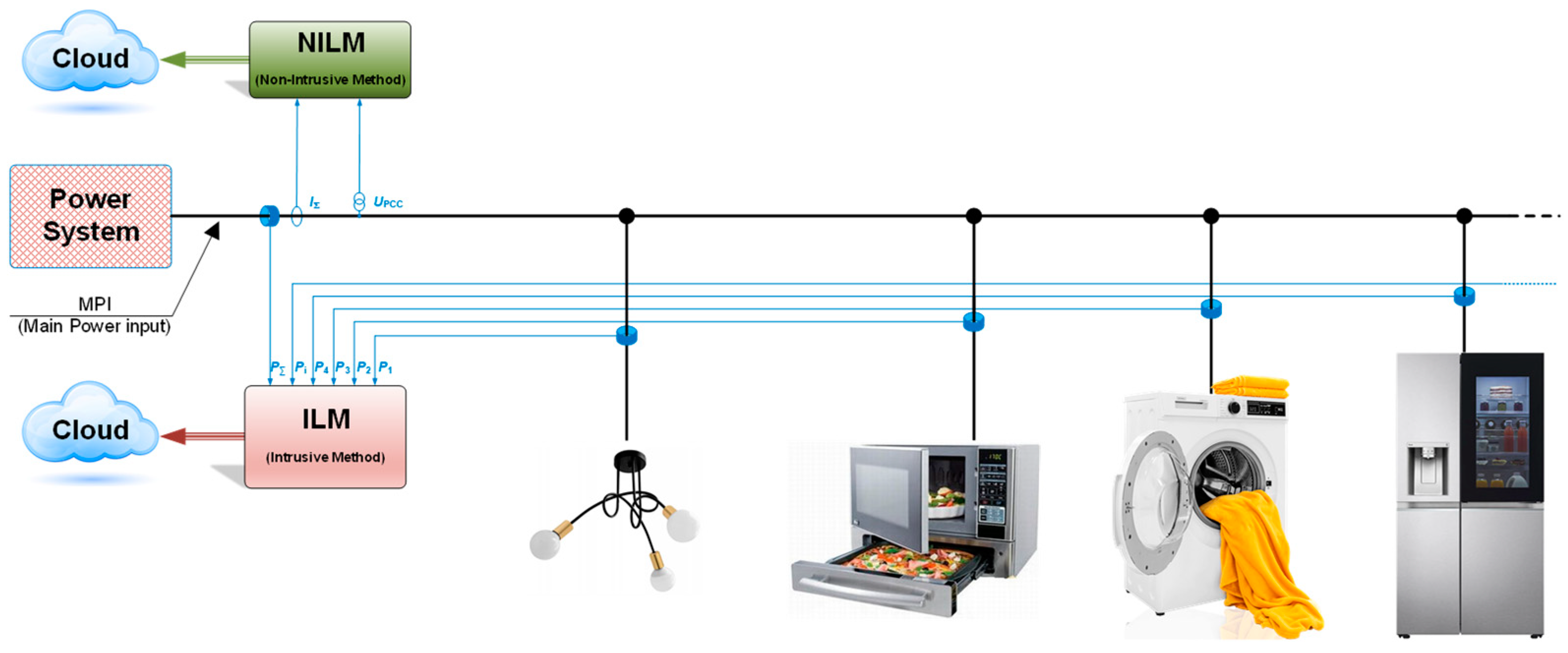

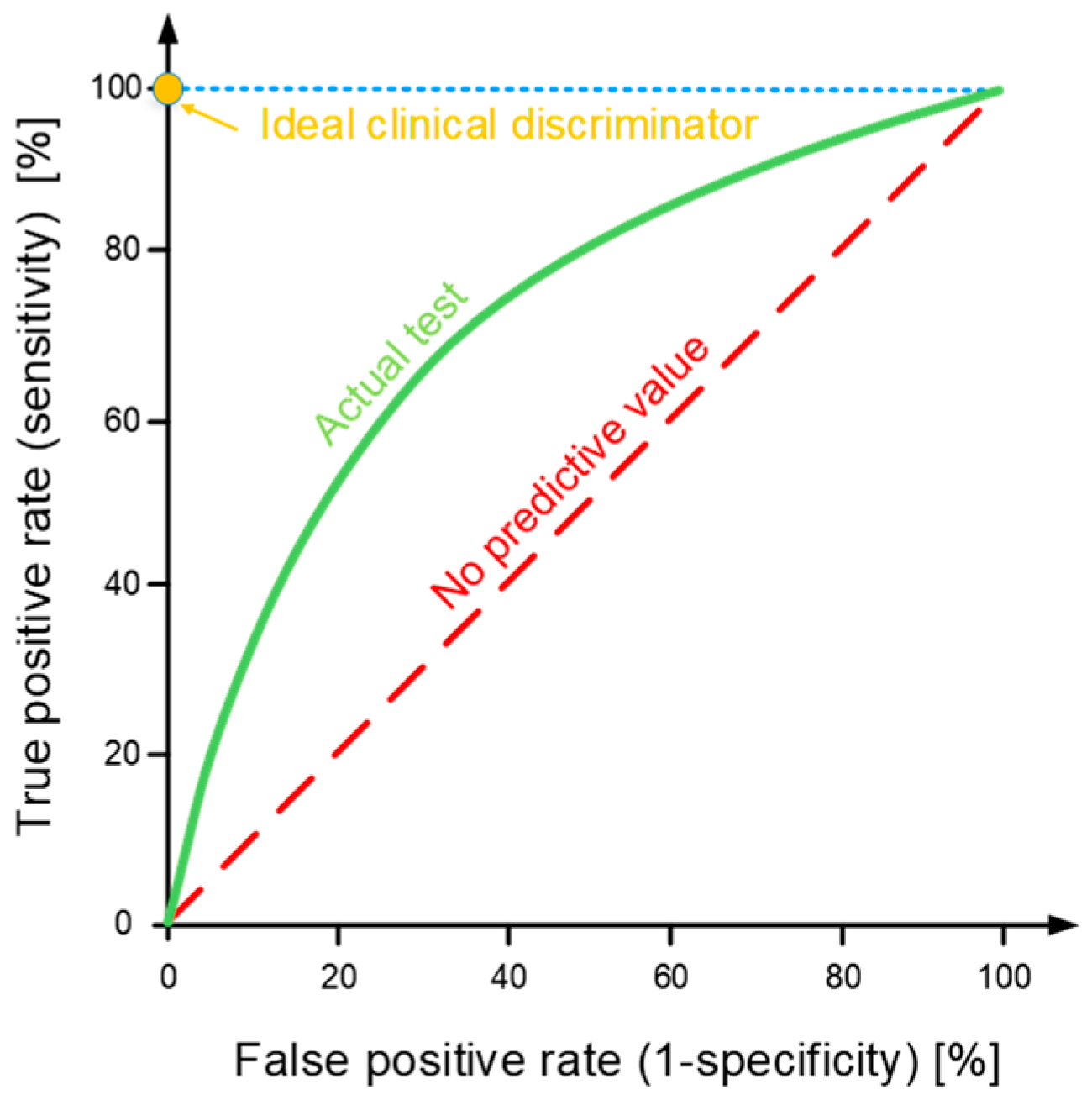
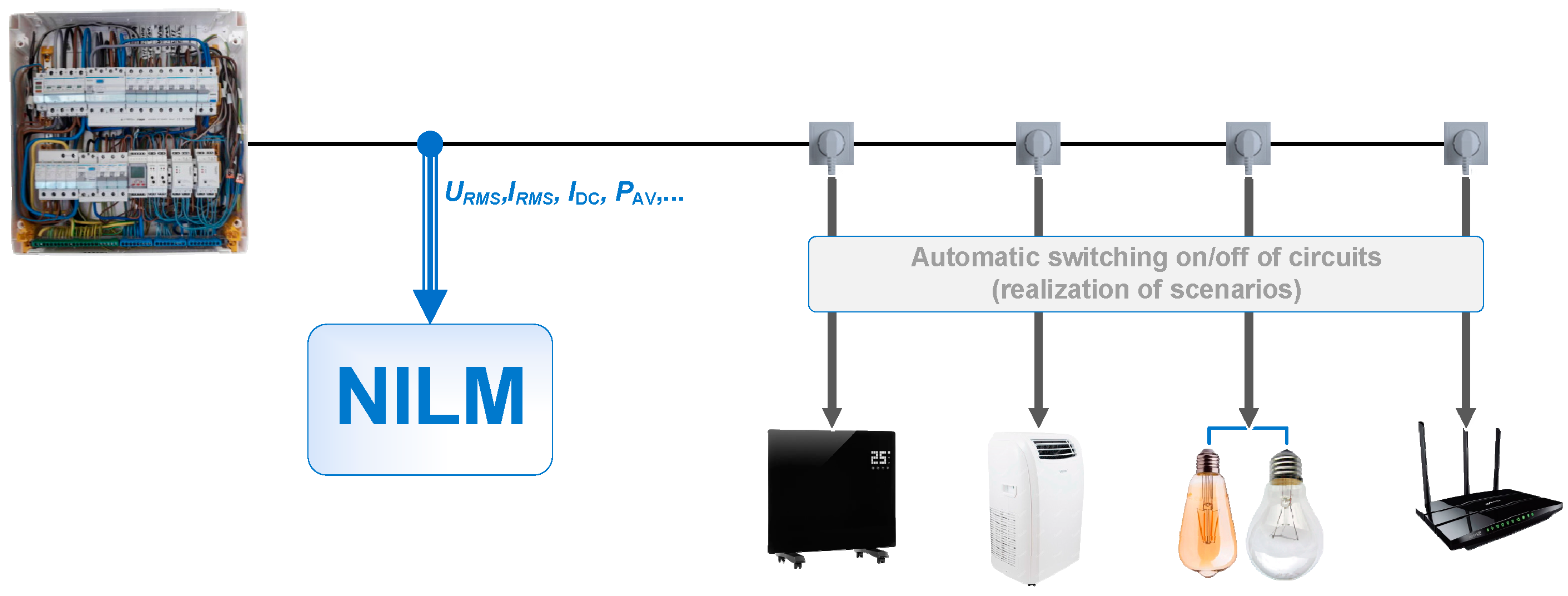

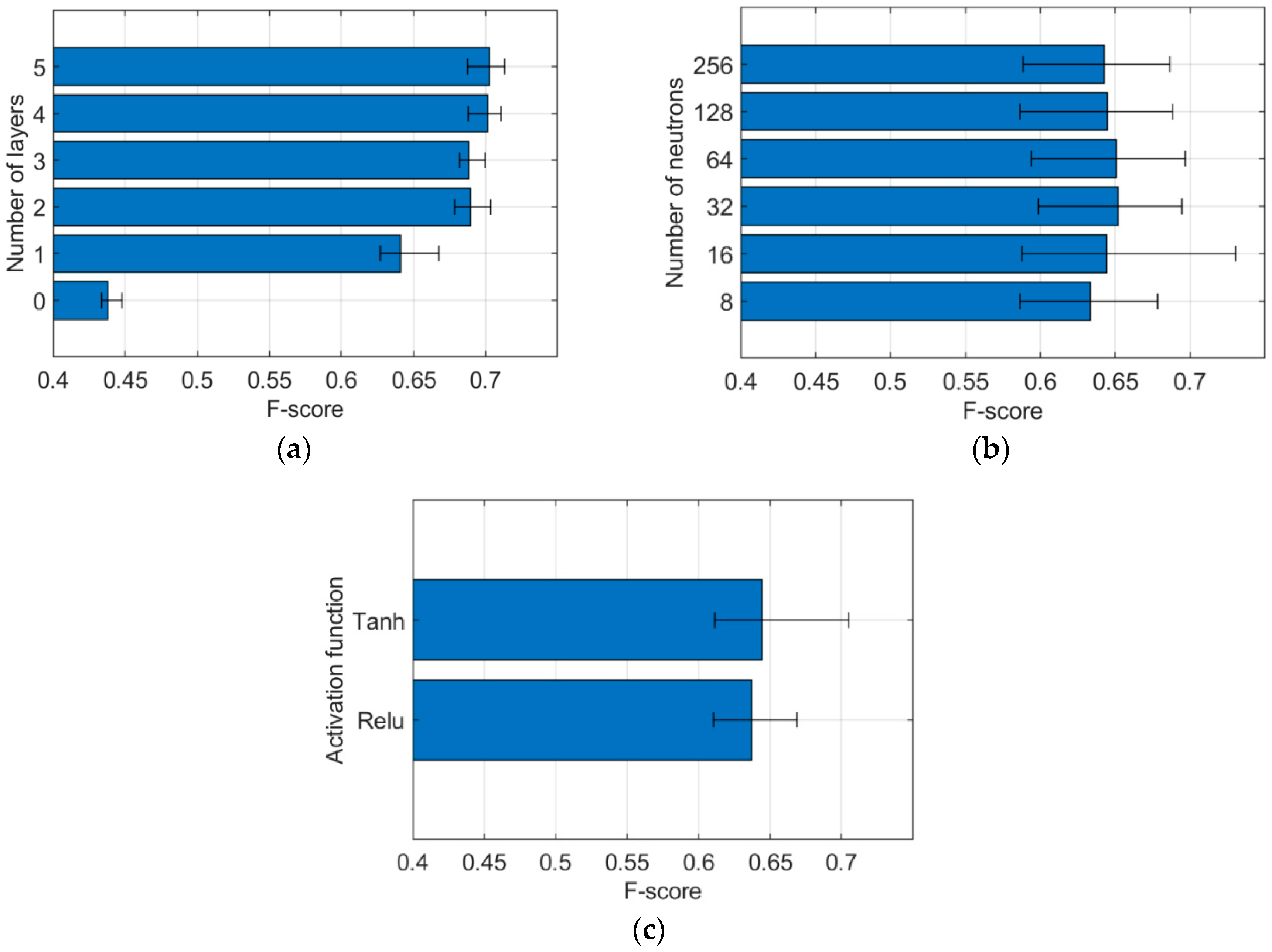
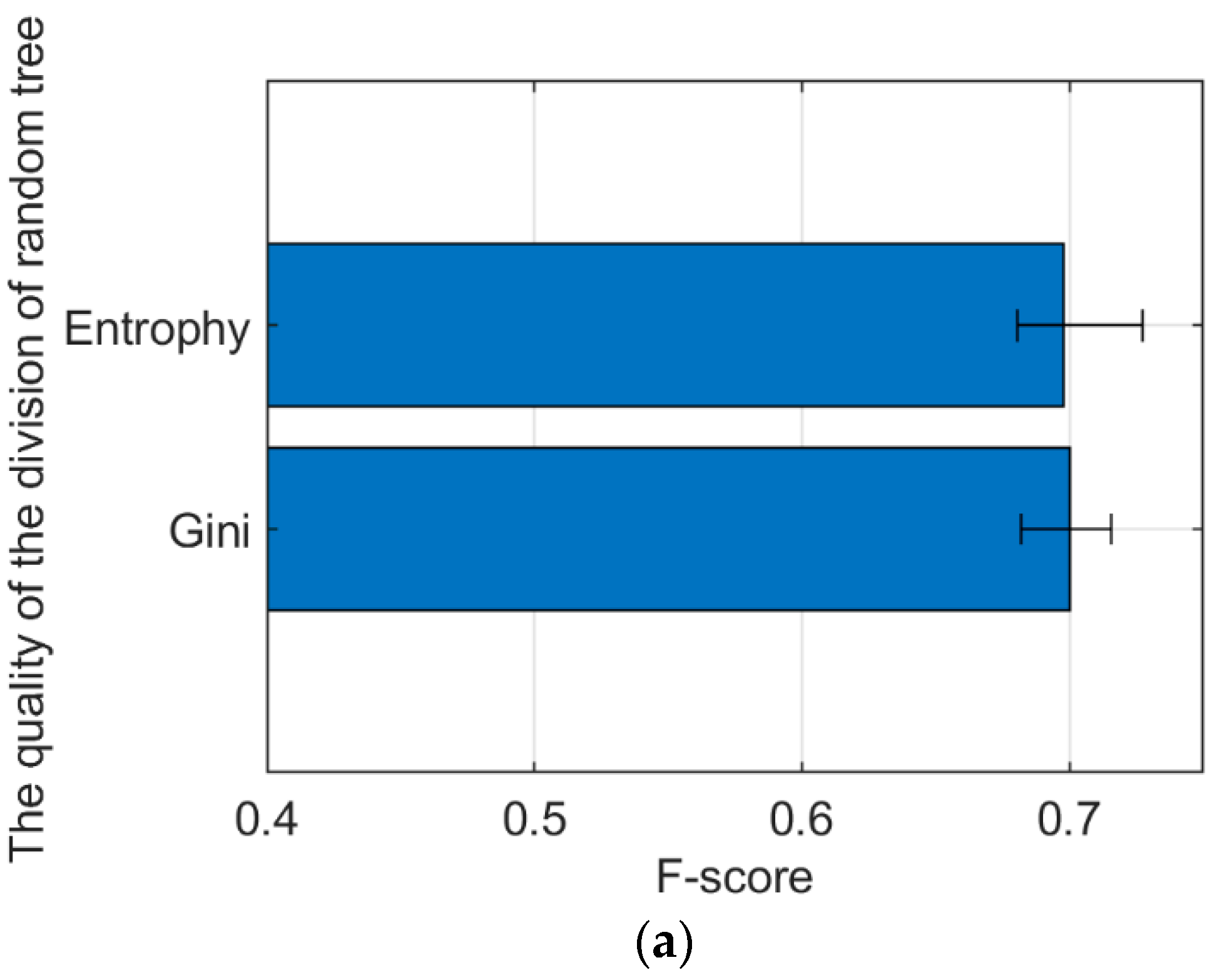
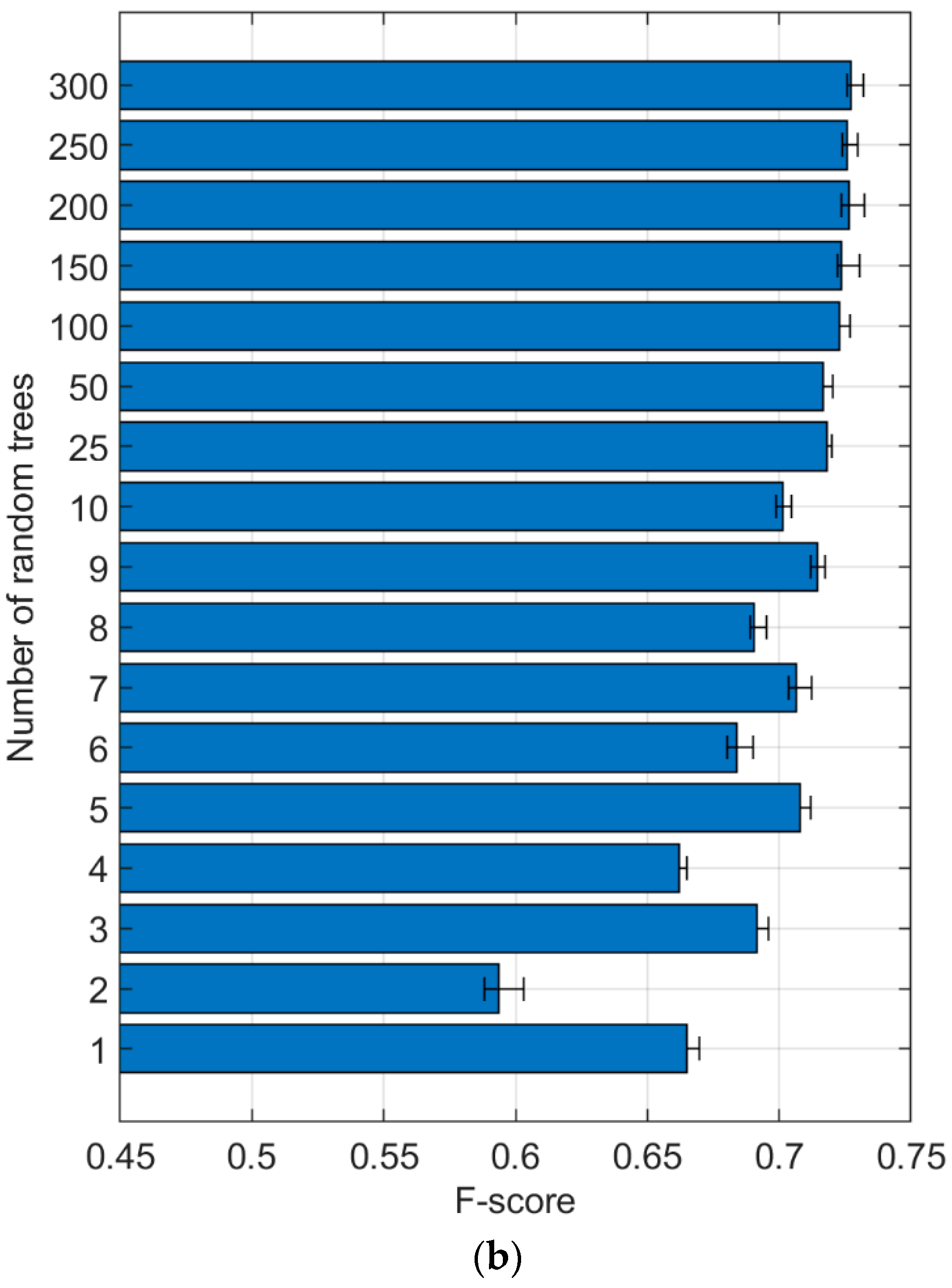
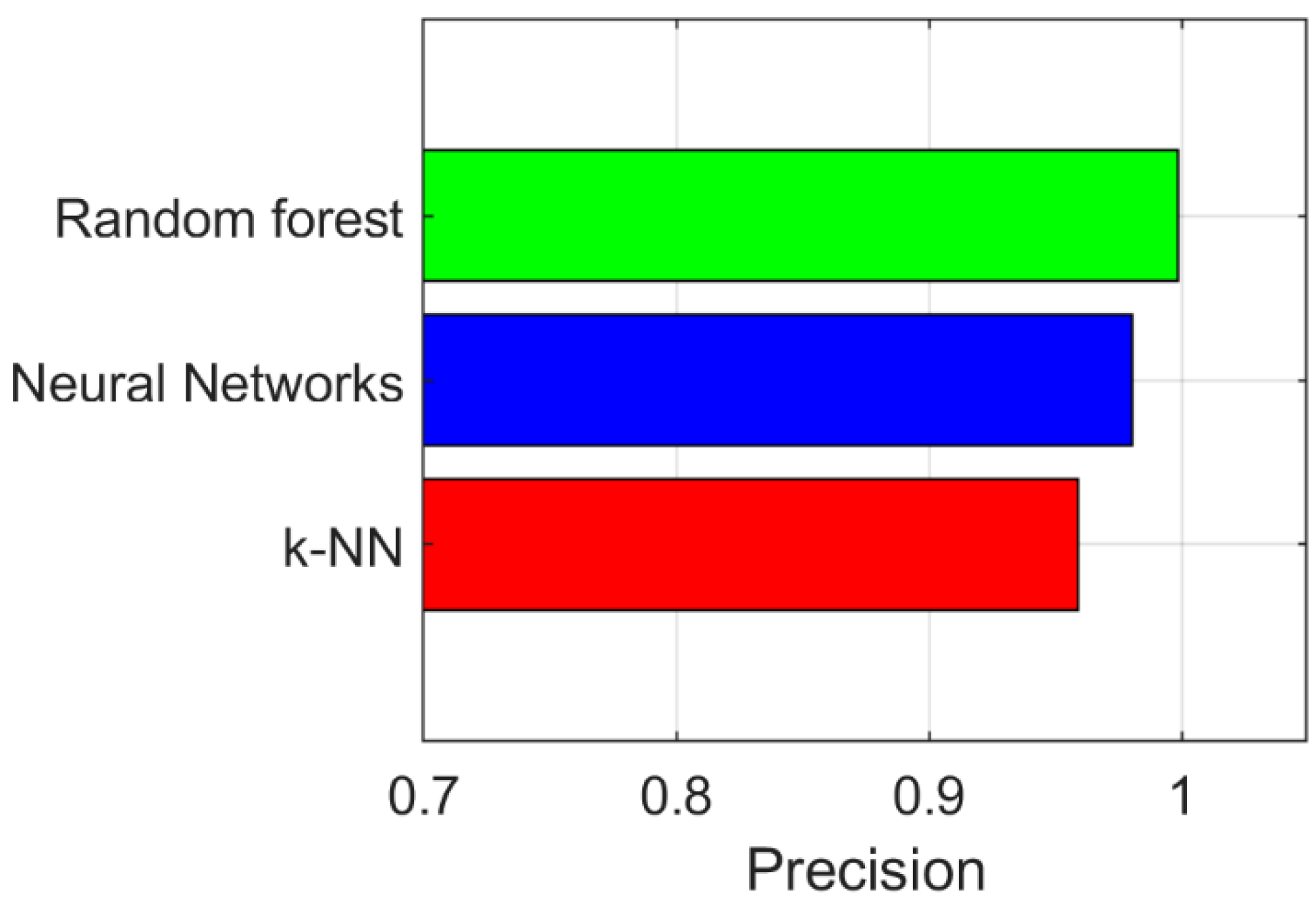
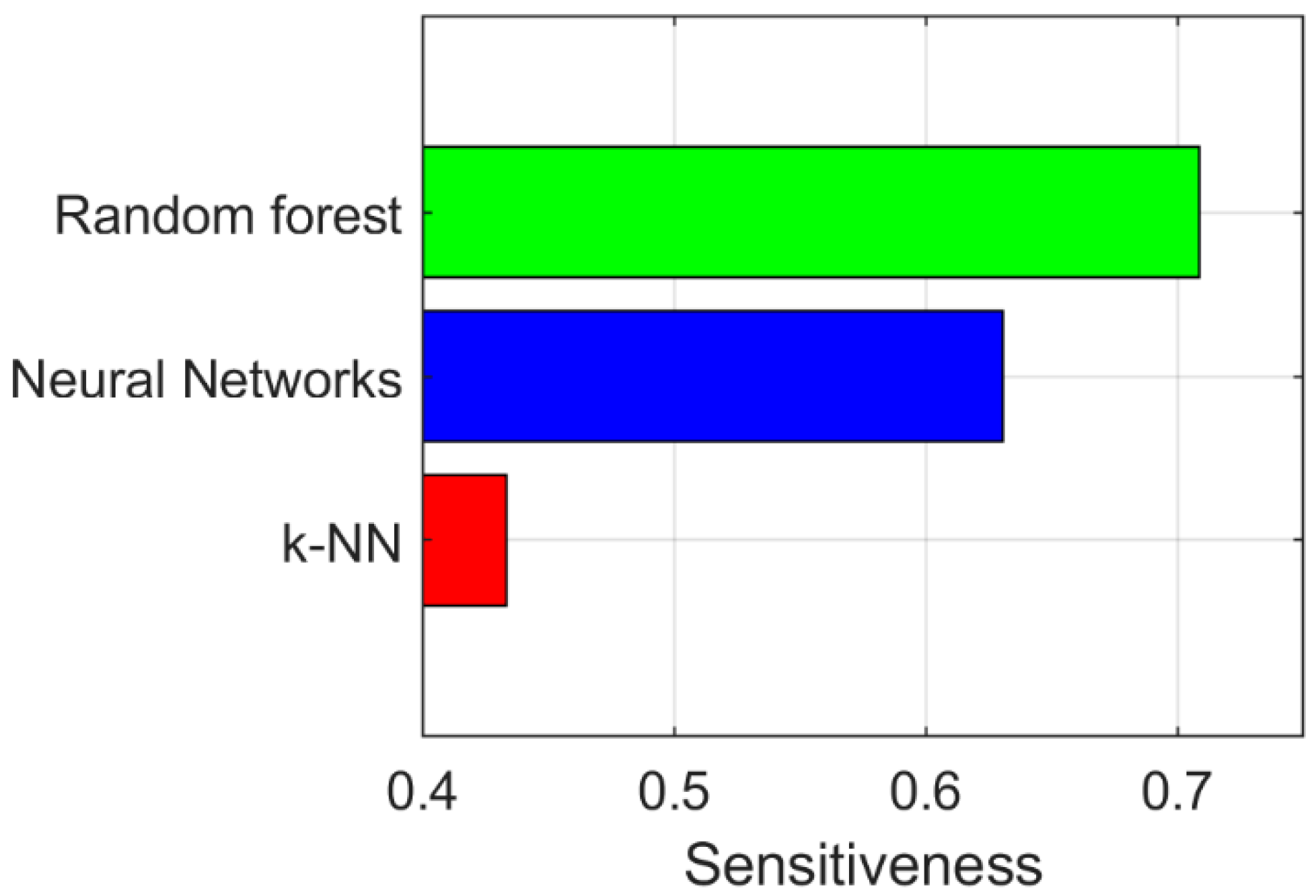
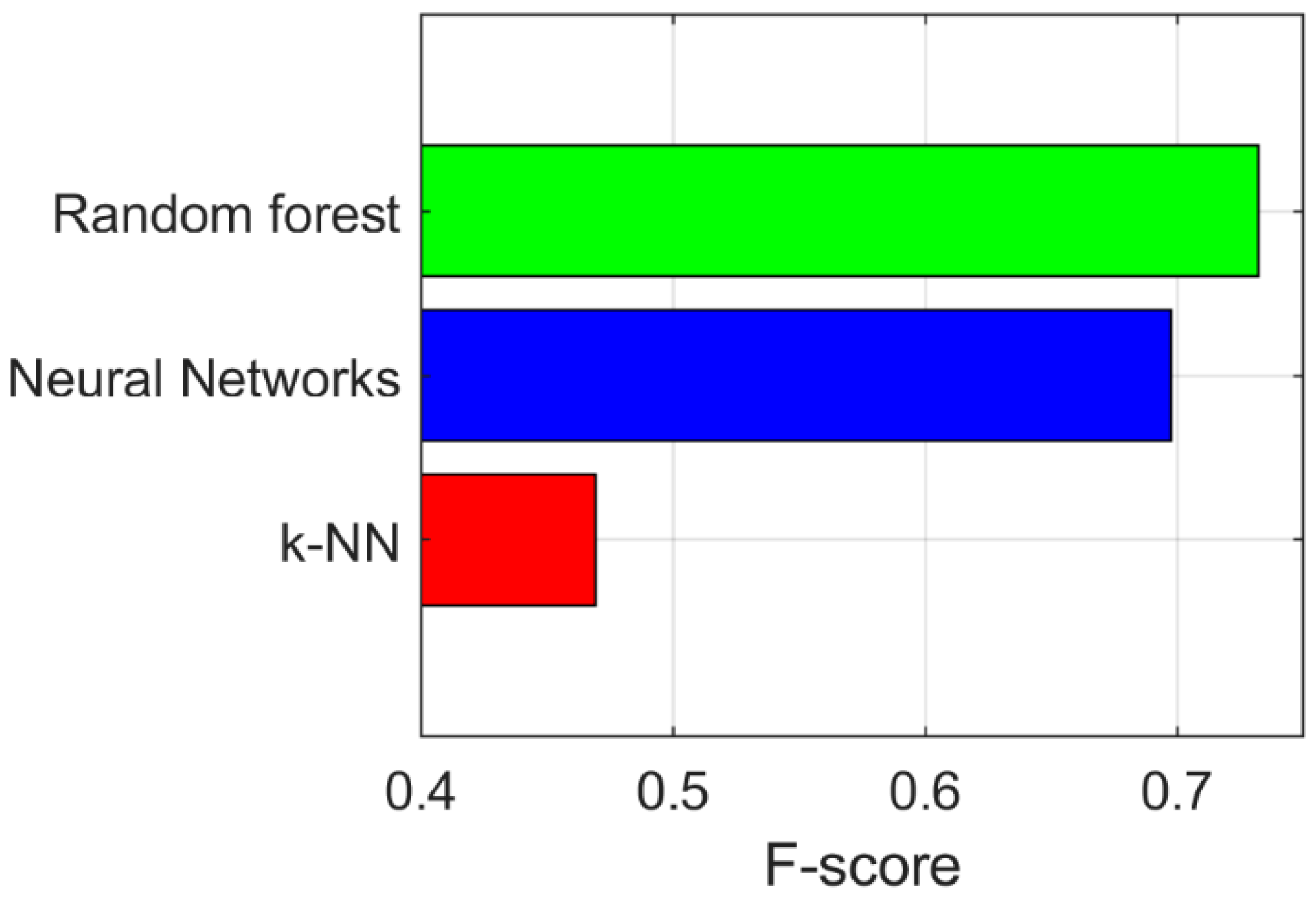



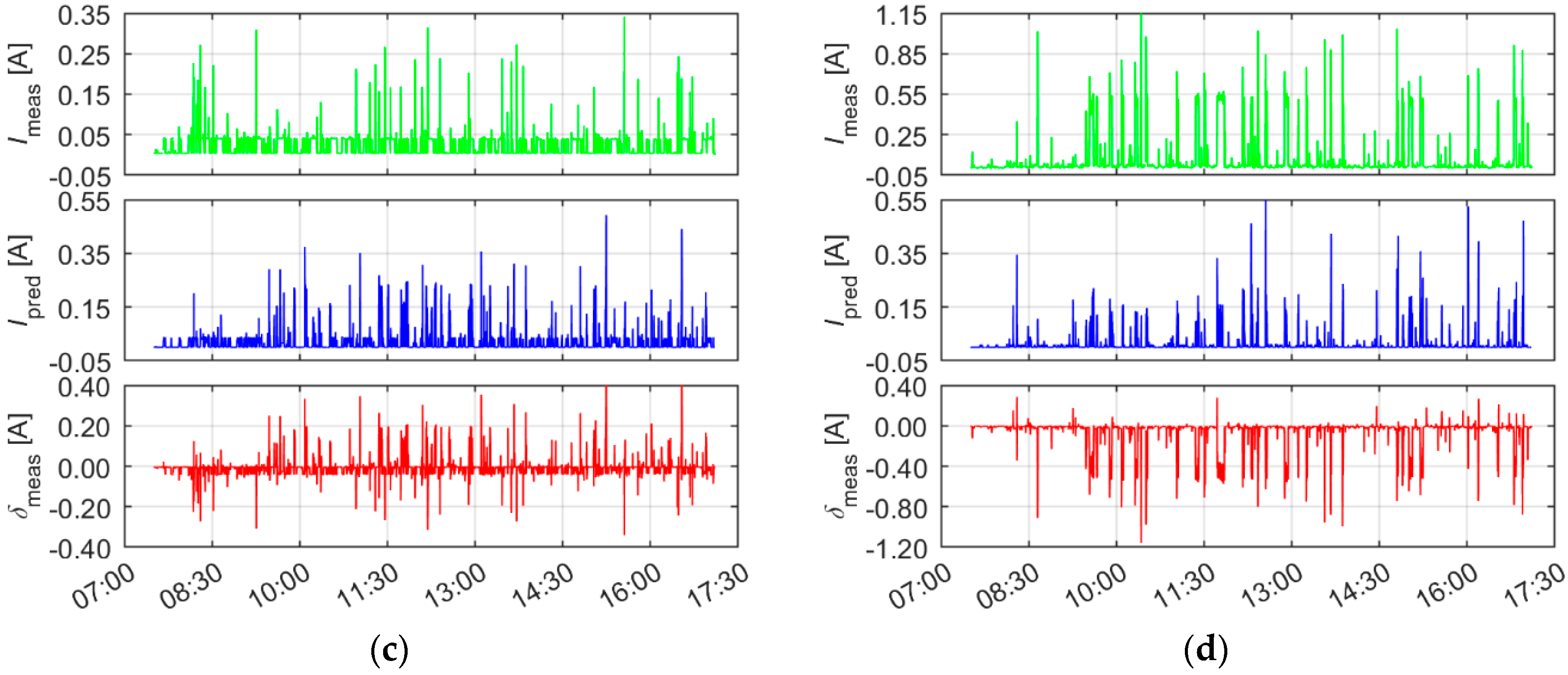
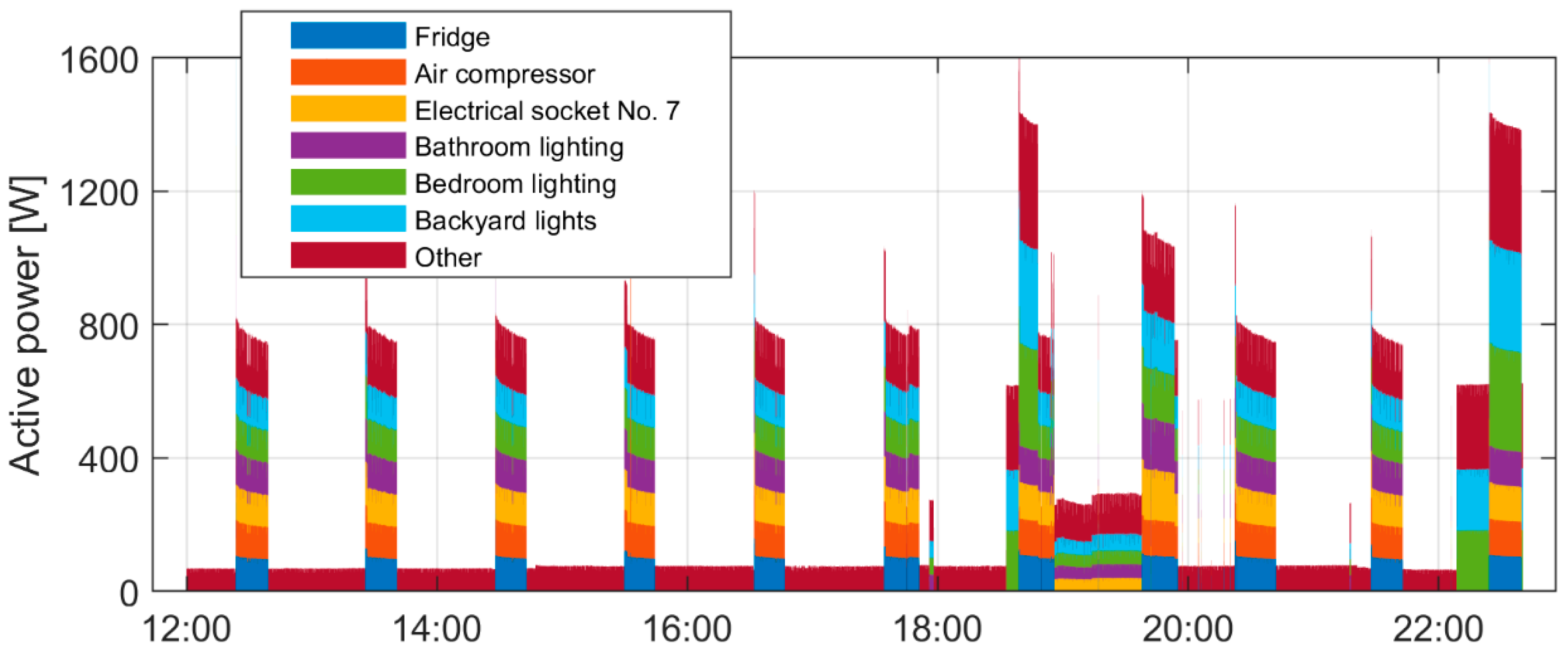
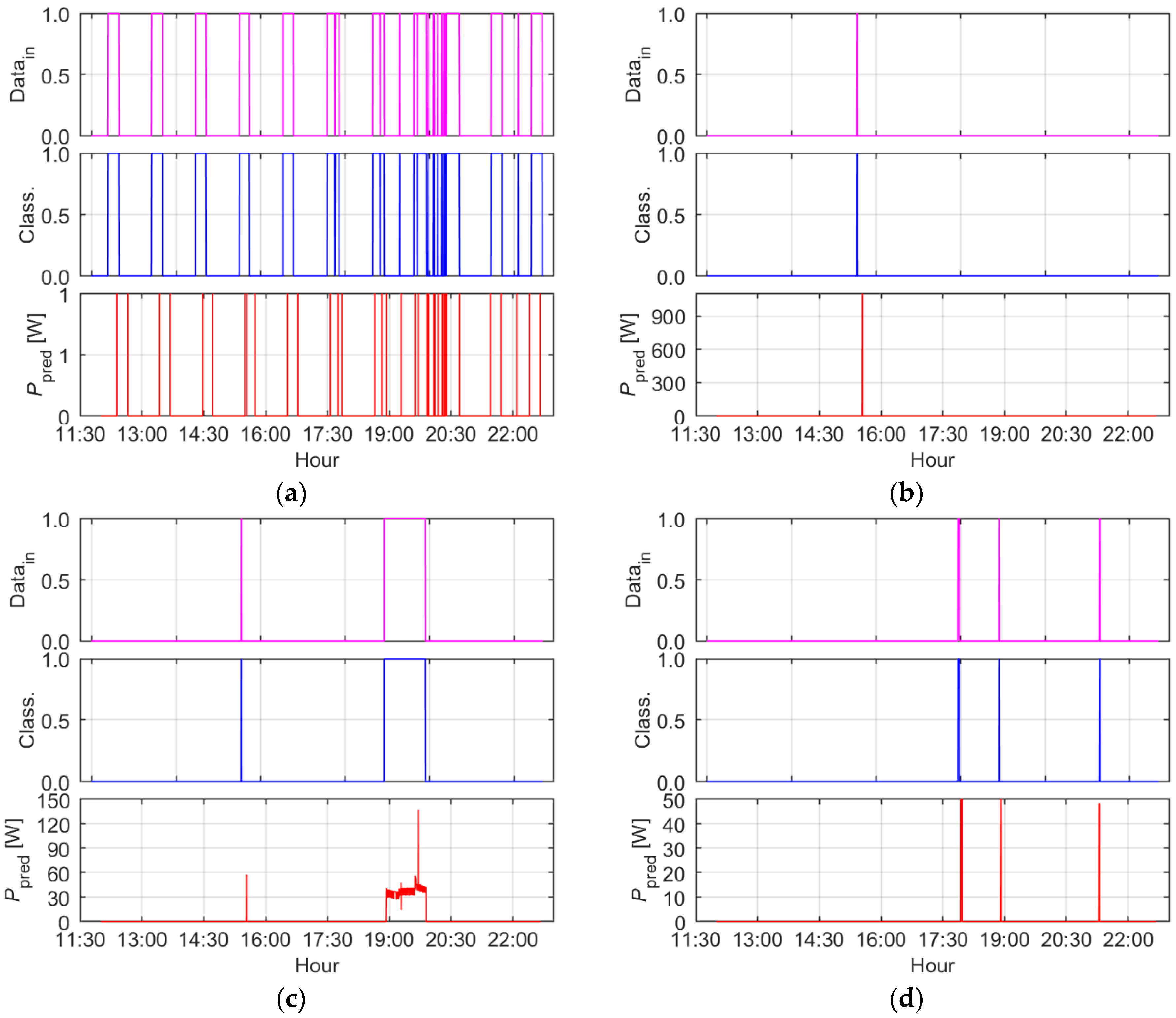
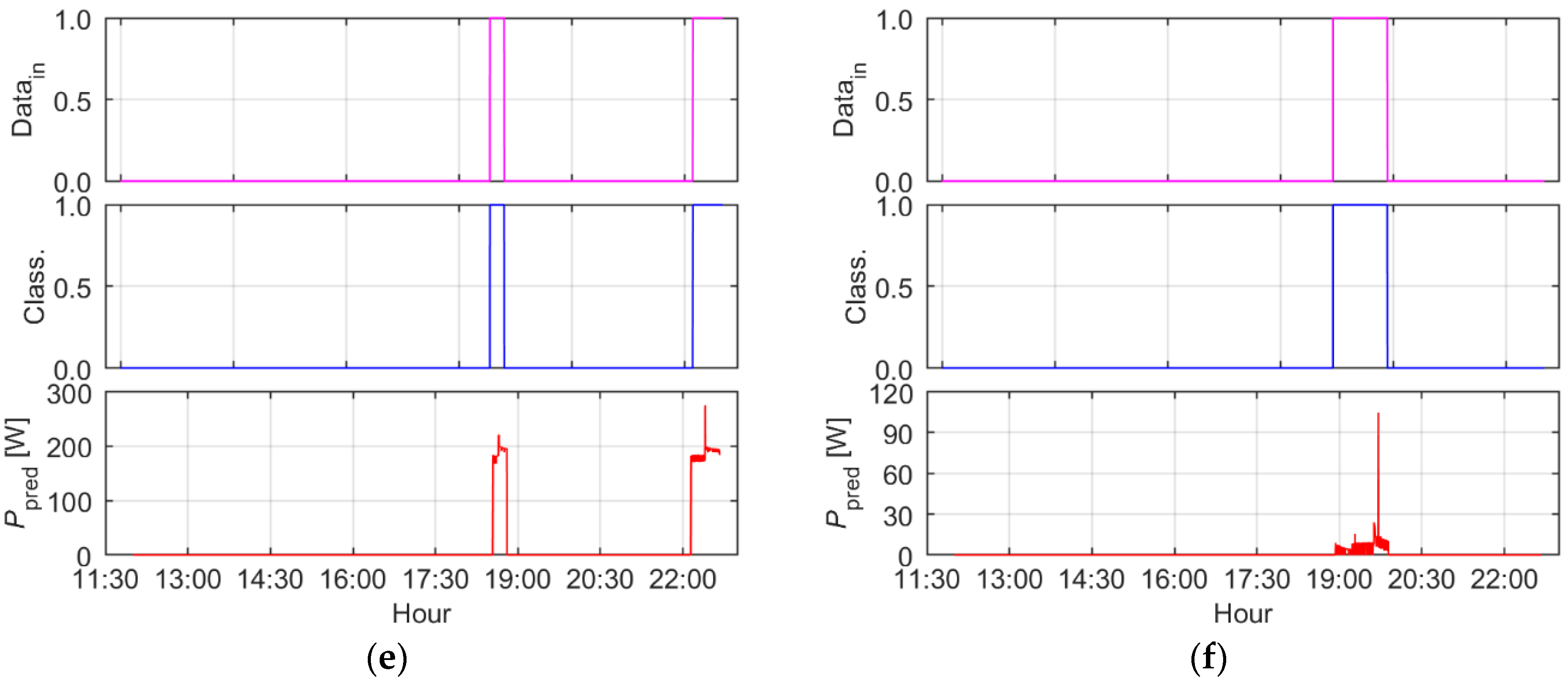

| Element | Description |
|---|---|
| Loads |
|
| Scenarios |
|
| Measurements |
|
Disclaimer/Publisher’s Note: The statements, opinions and data contained in all publications are solely those of the individual author(s) and contributor(s) and not of MDPI and/or the editor(s). MDPI and/or the editor(s) disclaim responsibility for any injury to people or property resulting from any ideas, methods, instructions or products referred to in the content. |
© 2023 by the authors. Licensee MDPI, Basel, Switzerland. This article is an open access article distributed under the terms and conditions of the Creative Commons Attribution (CC BY) license (https://creativecommons.org/licenses/by/4.0/).
Share and Cite
Gawin, B.; Małkowski, R.; Rink, R. Will NILM Technology Replace Multi-Meter Telemetry Systems for Monitoring Electricity Consumption? Energies 2023, 16, 2275. https://doi.org/10.3390/en16052275
Gawin B, Małkowski R, Rink R. Will NILM Technology Replace Multi-Meter Telemetry Systems for Monitoring Electricity Consumption? Energies. 2023; 16(5):2275. https://doi.org/10.3390/en16052275
Chicago/Turabian StyleGawin, Bartłomiej, Robert Małkowski, and Robert Rink. 2023. "Will NILM Technology Replace Multi-Meter Telemetry Systems for Monitoring Electricity Consumption?" Energies 16, no. 5: 2275. https://doi.org/10.3390/en16052275








